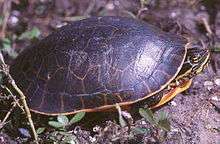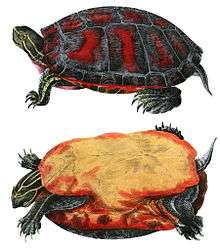Western chicken turtle
The western chicken turtle (Deirochelys reticularia miaria) is a small to medium-sized aquatic turtle.
| Deirochelys reticularia miaria | |
|---|---|
 | |
| Scientific classification | |
| Kingdom: | Animalia |
| Phylum: | Chordata |
| Class: | Reptilia |
| Order: | Testudines |
| Suborder: | Cryptodira |
| Superfamily: | Testudinoidea |
| Family: | Emydidae |
| Genus: | Deirochelys |
| Species: | |
| Subspecies: | D. r. miaria |
| Trinomial name | |
| Deirochelys reticularia miaria Schwartz, 1956 | |
Description
The egg-shaped carapace is rough textured without keels or marginal serrations and tends to be olive to brown in color. The vertebral scutes are broad, the first of which connects to four marginal and the cervical scute. The marginal scutes are yellow and may be blotched. The yellow plastron is unhinged and unmarked with the bridges containing one or two dark splotches. The skin of the western chicken turtle is olive to brown with yellow lines extending from the head across the neck, from the shoulder to the feet and vertically on the rump. The long narrow head comes to a point at the beak, which is neither hooked nor notched. The western chicken turtle received its common name from its long head and neck, which tends to be as long as the plastron. This species also exhibits sexual dimorphism with the female being larger than males.[1]
Range
The western chicken turtle ranges across the southeastern United States from Virginia to western Oklahoma and south to the Gulf of Mexico. There are three recognized subspecies: The Florida chicken turtle (D. r. chrysea) of the Florida peninsula, the western chicken turtle (D. r. miaria) of western Mississippi and all areas west of the Mississippi River, and the eastern chicken turtle (D. r. reticularia) which extends across the rest of the range. The western chicken turtle can be distinguished by its flattened shape, broad, faint lines on the carapace, and dark makings along the seams of the plastron.[1]
Habits
Most of what is known about this turtle has been reported in studies on the eastern subspecies (D. r. reticularia) in South Carolina.[2][3][4][5][6]
There, it is known to inhabit still waters, ponds, ditches, sloughs, and swamps. Fluctuating water with abundant aquatic vegetation is the optimal habitat. It is omnivorous and preys primarily on invertebrates.[3] The western chicken turtle will bask and frequently travels overland for a variety of activities including nesting, migration, estivation, and hibernation.[2] The eastern chicken turtle exhibits a bimodal nesting pattern, nesting both in August – September and February – March.[4][5][6]
References
- Ernst, C. H., J. E. Lovick, and R. W. Barbour. (1994). Turtles of the United States and Canada. Smithsonian Institution Press. Washington, D. C. xxxiii + 578 pp.
- Buhlmann, K. A. (1995). Habitat use, terrestrial movements, and conservation of the turtle, Deirochelys reticularia, in Virginia. J. Herpetol. 29:173-181.
- Demuth, J. P. and K A. Buhlmann. (1997). Diet of the turtle Deirochelys reticularia on the Savannah River Site, South Carolina. J. Herpetol. 31:450-453.
- Gibbons, J. W. (1969). Ecology and population dynamics of the chicken turtle, Deirochelys reticularia. Copeia 1969:669-676
- Gibbons, J. W. (1970). Terrestrial activity and the population dynamics of aquatic turtles. Amer. Midl. Natur. 83:404-414.
- Gibbons, J. W., J. L. Green. (1978). Selected aspects of the ecology of the chicken turtle, Deirochelys reticularia (Latreille) (Reptilia, Testudines, Emydidae). J. Herpetol. 12:237-241.
